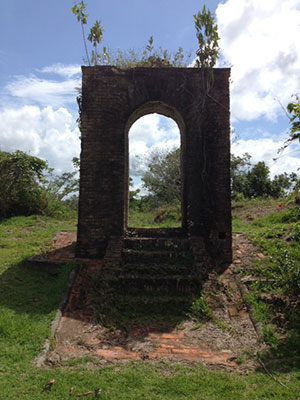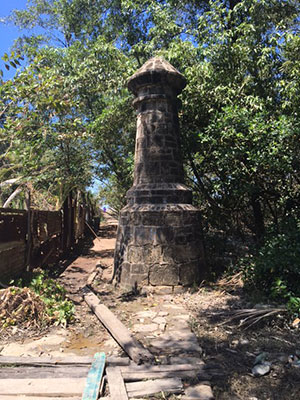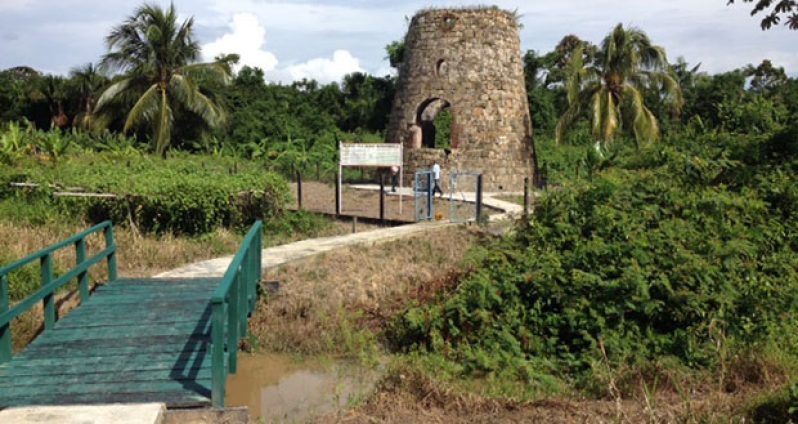by Francis Quamina Farrier
International Day of Monuments and Sites has slipped by unheralded, in this Guyana’s 50th Independence Anniversary year.That special day was April 18. However, as the saying goes “better late than never” and so here I am with this feature which throws the spotlight on some of our Monuments and Sites in our

beautiful Guyana. The International Council on Monuments and Sites has given the theme this year as “The Heritage of Sports”.
As such, it would be appropriate no doubt, for the Sports Department to throw the spotlight for just a bit, over the next few months, on the Cliff Anderson Sports Hall, and think of our Great Sportsmen and women of the past.
The late sprinter, Claudette Masdammer, who was the very first Guyanese to represent this country at the Olympics, should be remembered in some special way.
Distance runners such as Harry Prowell and Moses Dwarka and ace cyclists such as Laddie Lewis and George “Boy Blue” Cumberbatch should also be remembered, as well as a host of other sporting greats over the decades.
One of our most heralded monuments in Guyana is, of course, the 1763 Monument, which is located at the eastern end of Brickdam in Georgetown.
One of the most historic structures in Guyana is the centuries-old Court of Policy Building and the Fort Zeelandiaruins on the historic Fort Island, in the Essequibo River. The Indian Arrival Day Monument in the Monument Garden in Georgetown is also, like the 1763 monument and the Non-Aligned Monument, of more recent post-Independence vintage. There is also great significance of the Enmore Martyrs Monument on the East Coast Demerara.

So what is so special about Monuments and Sites? The International Council on Monuments and Sites made a proposal on April 18, 1982. It was approved by the UN General Assembly of UNESCO in 1983. The aim is to promote awareness about diversity of Cultural heritage of humanity, their vulnerability and efforts required for their protection and conservation.
Sites such as the Indigenous Rock Carvings in the South Rupununi and the giant ant hills in the Central Rupununi have been with us in some cases, for centuries. Humans need a bit of connection to the historic past, as we move forward into the unknown future. So we build monuments and we fence around important sites. We visit such places and we tell our children and grand-children what they mean. Most of us realize how important it is to build monuments and protect certain historic sites in our country.
Now, when last have you visited the Indian Monument at the Indian Monument Garden with entrance on Camp Street between Church Street and North Road in Georgetown? As a matter of fact, have you ever?
I have been into that beautiful floral garden on a number of occasions. But only when it is open to the Public on celebrations. It is so serene with the actual monument of a sailing ship – a replica of the original ships which brought Indentured East Indian Immigrants from India to British Guyana. I am not so sure that that Monument Gardens is open to the Public at all times. Maybe, it should be opened for a few weeks during this month of May, 2016, so that Guyanese and non-Guyanese and non-Guyanese alike, who will be visiting for the Jubilee Celebrations, could go and view the beautiful scenery.
If needs be, there could be a small fee which will go to take care of security and the cleaning of the site. I know that Dr.YesuPersaud has great influence with this Indian Monument gardens, and so I appeal to him to consider this proposal of mine.
The 1763 Monument is in an open space at the eastern end of Brickdam in Georgetown, and many visiting folks go and view it. There are also many Just Married couples who go there and take photographs and video recordings immediately after exchanging their Marriage vows and just before heading to the Wedding Reception venue. The 1763 Monument has from time to time, gone through good and not-so-good conditions. But the actual monument is always very impressive and imposing. There have been some recommendations that the area in front of it – the Square of the Revolution – should be fenced off. That the area should be regarded as special and no longer be used for Learner Drivers and other similar mundane exercises. At the bottom or western end of Brickdam, is the Public Buildings. That concrete edifice was designed by Joseph Hadfield, and the street at the back or southern side of the Public Buildings, bears his name. The foundation stone of that building was laid in 1829. Its construction was by the talented African enslaved construction workers. Construction was completed in April 1834 – before Emancipation.
here are now concrete structures here in Guyana which have been built during the last 25 years, which have had to be demolished due to sloppy construction work.
Other concrete monuments which have stood the test of time, are the Dutch Court of Policy Hall on Fort Island in the Essequibo river, the Arch on the Mazaruni Island of Kyk-over-Al, the St. Peter’s Anglican Church on the Essequibo river island of Leguan and the High Bridge at Anna Regina on the Essequibo Coast.
There is also the Water Wheel at Christianburg, Linden, on the Upper Demerara river. Some of the oldest monuments are the Indigenous Rock Carvings scattered across many areas of our hinterland; the Rock Carvings at Aishalton in the deep South Rupununi, for example, and those on the Upper Mazaruni river, as well.
On the Upper Berbiceriver, there are some graves of the Dutch at Fort Nassau. That is where Governor Cuffy had set up his headquarters at his short-lived Revolution back in 1763. More recent in construction, is the Non-Aligned Monument located in the Company Path Garden just west of the magnificent wooden St. George’s Cathedral in Georgetown.
In it are the four busts of the fathers of the Non-Aligned Movement – President Gamal Abdel Nasser of Egypt, President Kwame Nkrumah of Ghana, President Jawaharlal Nehru of India and President Josip Broz Tito of Yugoslavia.
While the Non-Aligned is one of the better known monuments in Guyana, there are quite a number which are hardly known. There is one which has been tucked away among the mangroves on the north Vreed-en-Hoop mudflat in Region Number Three. Very little is known of its origin, and so far, I have been unable to find out anything substantial about it. So, if you are looking for a monument which is almost unknown, but easily accessible, then go to Vreed-en-Hoop by the traffic lights and ask directions to ‘Plastic City’ which is just 30 seconds by car. You will then take a three minute walk along the old river defense wall, going north past some shacks at your left, then there, in front of you, is that unique monument. Bytheway, you must also visit that monument for Children which is located at the western side of the National Park in Georgetown.
As we belatedly focus on some of Guyana’s Monuments and Sites, let us always remember to care for them, no matter how small or unknown, or how large and important, like the Kaieteur National Park, on the Potaro river in Region Number Eight.




.png)









